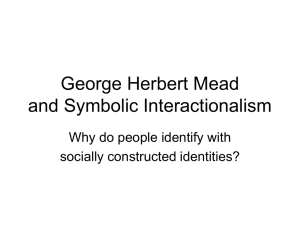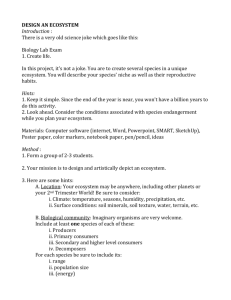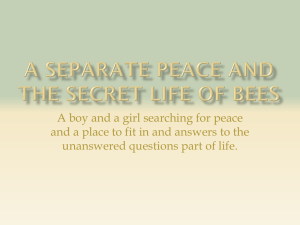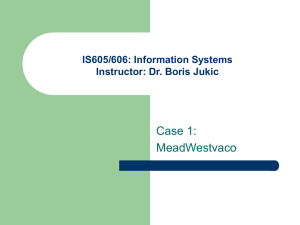design_ecosystem_example
advertisement
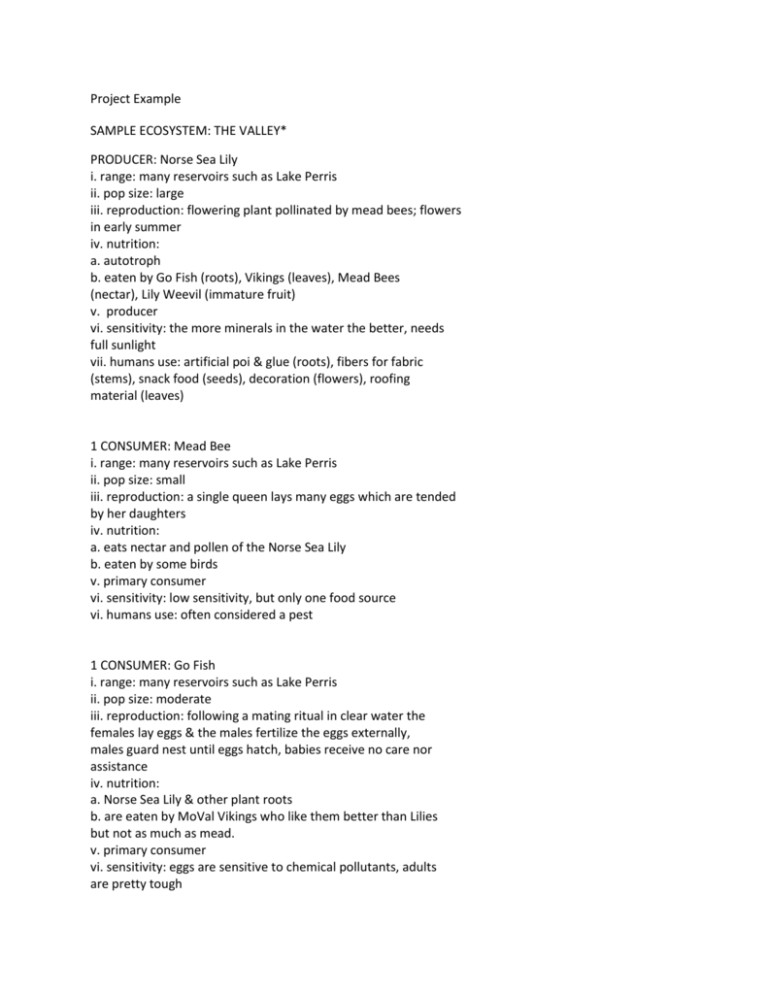
Project Example SAMPLE ECOSYSTEM: THE VALLEY* PRODUCER: Norse Sea Lily i. range: many reservoirs such as Lake Perris ii. pop size: large iii. reproduction: flowering plant pollinated by mead bees; flowers in early summer iv. nutrition: a. autotroph b. eaten by Go Fish (roots), Vikings (leaves), Mead Bees (nectar), Lily Weevil (immature fruit) v. producer vi. sensitivity: the more minerals in the water the better, needs full sunlight vii. humans use: artificial poi & glue (roots), fibers for fabric (stems), snack food (seeds), decoration (flowers), roofing material (leaves) 1 CONSUMER: Mead Bee i. range: many reservoirs such as Lake Perris ii. pop size: small iii. reproduction: a single queen lays many eggs which are tended by her daughters iv. nutrition: a. eats nectar and pollen of the Norse Sea Lily b. eaten by some birds v. primary consumer vi. sensitivity: low sensitivity, but only one food source vi. humans use: often considered a pest 1 CONSUMER: Go Fish i. range: many reservoirs such as Lake Perris ii. pop size: moderate iii. reproduction: following a mating ritual in clear water the females lay eggs & the males fertilize the eggs externally, males guard nest until eggs hatch, babies receive no care nor assistance iv. nutrition: a. Norse Sea Lily & other plant roots b. are eaten by MoVal Vikings who like them better than Lilies but not as much as mead. v. primary consumer vi. sensitivity: eggs are sensitive to chemical pollutants, adults are pretty tough vii. human use: sport and food fish 1 CONSUMER/2 CONSUMER: MoVal Viking** i. range: southern California ii. pop size: many 1000s iii. reproduction: life-long pair bonds, internal fertilization, low birth rate, extensive care of young iv. nutrition: a. Go Fish, mead, lilies, eagles, cougars & broccoli b. top level predator v. secondary consumer vi. sensitivity: low chemical sensitivity, sudden temperature change can harm them vii. humans use: extremely attractive exotic pets 1 CONSUMER/DECOMPOSER: Yeast Beast i. range: very limited, only in Mead Bee hives ii. pop size: moderate in hives, zero elsewhere iii. reproduction: high fecundity: usually asexual budding iv. nutrition: a. eats nectar and pollen brought to hive by bee excretes mead b. Vikings drink mead. Vikings really like that mead v. decomposer vi. sensitivity: low sensitivity to chemicals vii. humans use: no known use DECOMPOSER: Ship Worm i. range: many reservoirs such as Lake Perris ii. pop size: large iii. reproduction: hermaphroditic, lay many eggs, external fertilization, no care of young iv. nutrition: a. eats dead organic matter b. eats anything & everything, once it's died v. decomposer vi. sensitivity: low sensitivity to chemicals, light, temp or salinity change vii. humans use: no known use, humans think they are ugly SAMPLE EIR ENVIRONMENTAL CHANGE: A gravid (pregnant) Lily Weevil is inadvertently introduced into the valley. The Lily Weevil eats immature Norse Sea Lily fruit. Worse yet are its reproductive habits. It parasitizes hymenopterans by stinging them into paralysis and laying a single egg in the abdomen of each insect. The Weevil larva then feeds upon its host from the inside out! Needless to say, this is an experience which a Mead Bee does not survive. IMPACT ON SPECIES: Extinct : At this time it is not possible to tell whether any of these organisms would actually go extinct. However endangerment, by definition, means that a species might go extinct in the near future. Endangered: Mead Bee: Bees are being massacred by the Lily Weevil, a newly introduced species. Yeast Beast: Yeast Beasts are totally dependent on Mead Bees. If the Mead Bee dies out, so will the Yeast Beast. Norse Sea Lily: Not only do Weevils eat their fruit before their seeds have formed, they also parasitize the Lily's only pollinator. The Lily may not be able to reproduce in the presence of the Weevil. Finally, human predation may also contribute to their demise. Threatened: MoVal Viking: The Vikings could loose three important food sources: Lilies, Go Fish, and mead. Fortunately, Vikings have other food sources available to them. Go Fish: Go Fish would loose a major food source. Also Vikings may predate more heavily upon the fish since the Vikings no longer have Lilies and mead. No Change : Ship Worm: One way or the other, there will be plenty of dead for the Ship Worm to eat. Increased: Lily Weevil: Since the valley is full of food (Lilies) and reproductive opportunities (Bees), Weevils may increase in population. Contributing to their increase is the lack of natural predators such as Leaping Lizards which eat them. MITIGATION : Prevent entry of the Lily Weevil: Prevent, or at least delay entry, of this dreaded pest. Recommended practices include: Do not import, or import only after quarantine, agricultural products, such as aquarium and pond plants, which may be infested with the Lily Weevil. While this idea is sound, it may be difficult to carry out. Backyard pond enthusiasts may not understand the need for not smuggling various exotic plants which they would like to grow at home. Population control for the Lily Weevil: If entry cannot be prevented, methods of limiting Weevil population must be explored. For example: Pesticides: Some pesticides kill Lily Weevil effectively; but others are no longer effective since the Lily Weevil has evolved resistance to them. Also, the same pesticides that kill Weevils, kills Mead Bees. This solution has only limited viability. Introduction of Weevil predator: A population of Leaping Lizards could be introduced to the valley. Lizards would keep the Weevil population low. They would not completely eradicate the Weevil. Prior to their introduction, extensive research is recommended as it is not known what other organisms would be effected by the Lizards. For example: would Leaping Lizards eat Mead Bees; out compete the local Friendly Frog for insect food; or in some other way become a pest?
